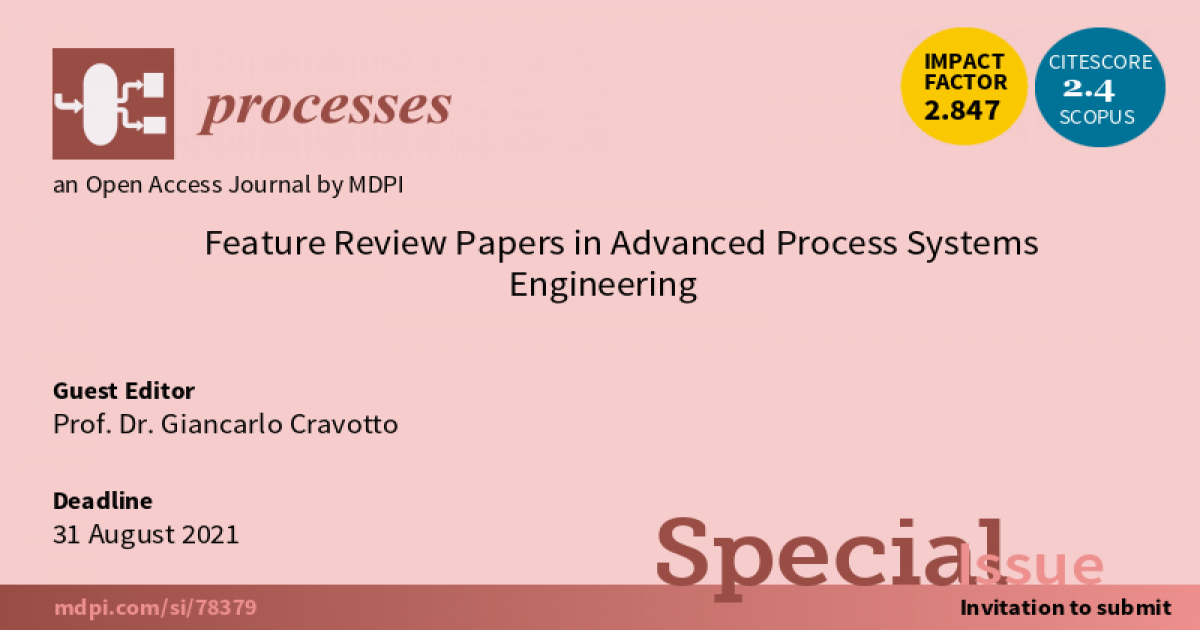Feature Review Papers in Advanced Process Systems Engineering
A special issue of Processes (ISSN 2227-9717).
Deadline for manuscript submissions: closed (30 April 2022) | Viewed by 68420

Special Issue Editor
Interests: green chemistry; process intensification; green extraction; enabling technologies (ultrasound, microwaves, hydrodynamic cavitation, ball milling, flow chemistry); sustainable chemical processes
Special Issues, Collections and Topics in MDPI journals
Special Issue Information
Dear Colleagues,
Processes is looking at the new design of research laboratories and at the industry 4.0, with the advantages introduced by artificial intelligence, and statistical design of experiments in combination with automated systems. This could contribute to developing more efficient, greener, safer, more cost-effective, and more sustainable production chains. On the other hand, bottlenecks are often related to the difficult scaling up of highly efficient enabling technologies well established in research labs. This is often worsened by the high CAPEX. It is noteworthy that, focusing on transdisciplinary strategies, new promising scenarios could be opened. This evolution requires that business models be rethought to achieve more sustainable production paths to improve manufacturing and process flexibility and decrease environmental impact, production costs, energy consumption, and waste generation.
This Special Issue is designed to publish high-quality review papers in Processes. The issue will highlight a diverse set of topics related to process and systems technology for chemical, biology, materials, biochemical, pharmaceutical, and biomedical applications. The scope of this Special Issue includes but is not limited to chemical and biochemical processes; cellular systems; material manufacturing; and systems modeling, simulation, optimization, and control. We are particularly interested in receiving manuscripts that review experimental and theoretical/computational studies as well as contributions from the industry.
Prof. Dr. Giancarlo Cravotto
Guest Editor
Manuscript Submission Information
Manuscripts should be submitted online at www.mdpi.com by registering and logging in to this website. Once you are registered, click here to go to the submission form. Manuscripts can be submitted until the deadline. All submissions that pass pre-check are peer-reviewed. Accepted papers will be published continuously in the journal (as soon as accepted) and will be listed together on the special issue website. Research articles, review articles as well as short communications are invited. For planned papers, a title and short abstract (about 100 words) can be sent to the Editorial Office for announcement on this website.
Submitted manuscripts should not have been published previously, nor be under consideration for publication elsewhere (except conference proceedings papers). All manuscripts are thoroughly refereed through a single-blind peer-review process. A guide for authors and other relevant information for submission of manuscripts is available on the Instructions for Authors page. Processes is an international peer-reviewed open access monthly journal published by MDPI.
Please visit the Instructions for Authors page before submitting a manuscript. The Article Processing Charge (APC) for publication in this open access journal is 2400 CHF (Swiss Francs). Submitted papers should be well formatted and use good English. Authors may use MDPI's English editing service prior to publication or during author revisions.
Keywords
- chemical systems
- biological systems
- materials processes
- green processes
- pharmaceutical processes
- food processes
- energy systems
- process control and supervision
- manufacturing processes
- advanced digital and other processes
Benefits of Publishing in a Special Issue
- Ease of navigation: Grouping papers by topic helps scholars navigate broad scope journals more efficiently.
- Greater discoverability: Special Issues support the reach and impact of scientific research. Articles in Special Issues are more discoverable and cited more frequently.
- Expansion of research network: Special Issues facilitate connections among authors, fostering scientific collaborations.
- External promotion: Articles in Special Issues are often promoted through the journal's social media, increasing their visibility.
- Reprint: MDPI Books provides the opportunity to republish successful Special Issues in book format, both online and in print.
Further information on MDPI's Special Issue policies can be found here.





